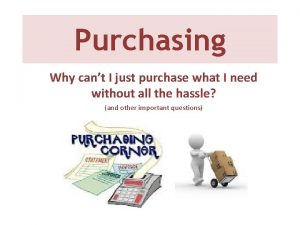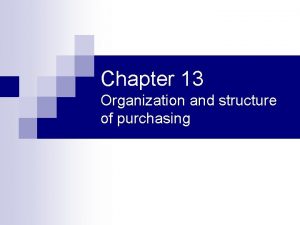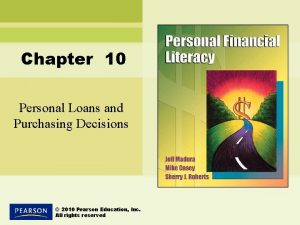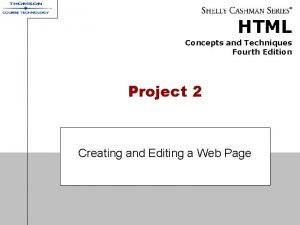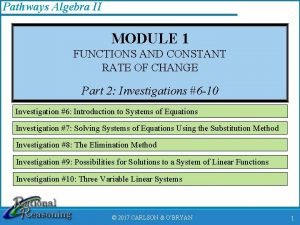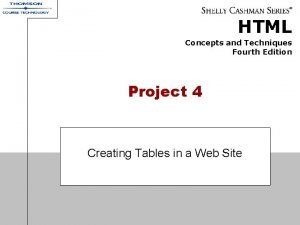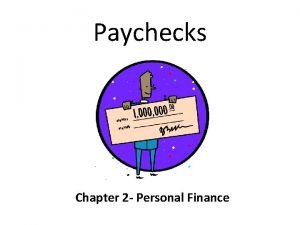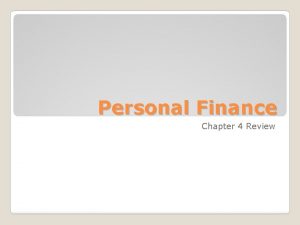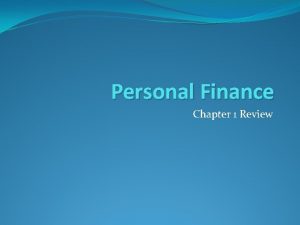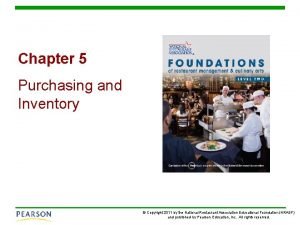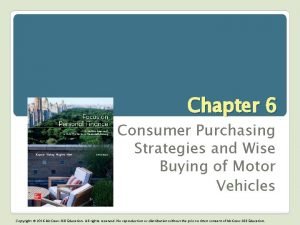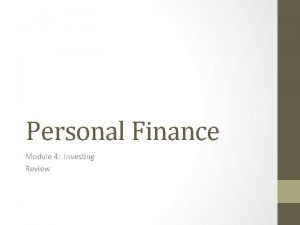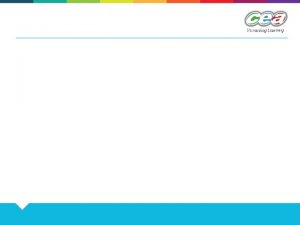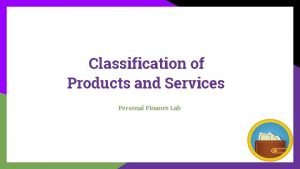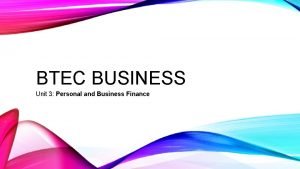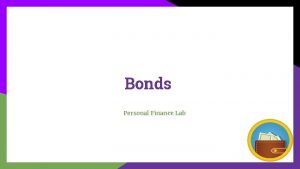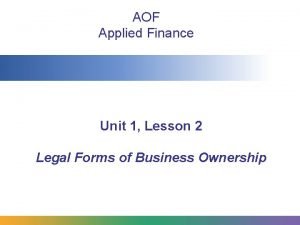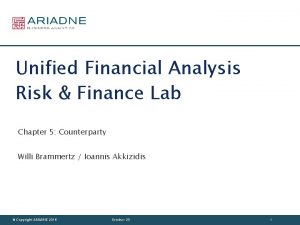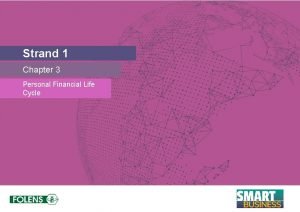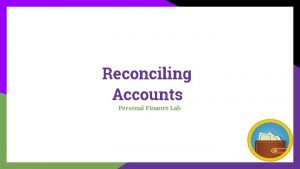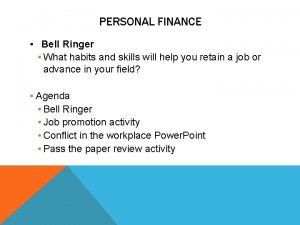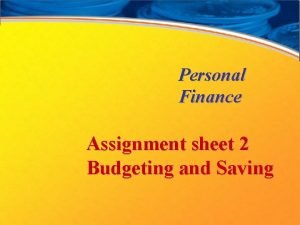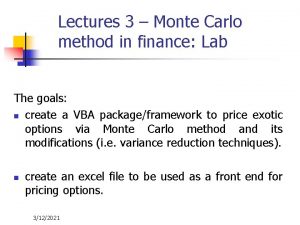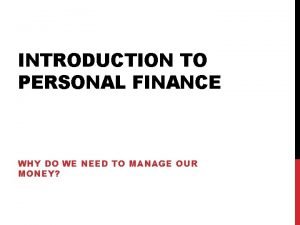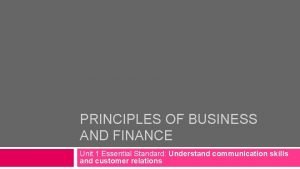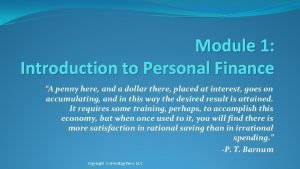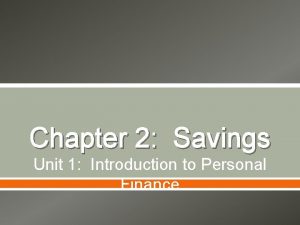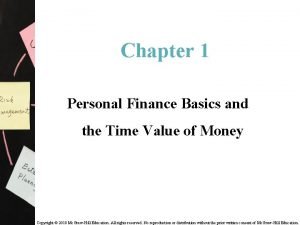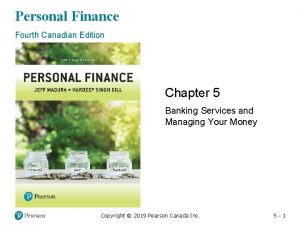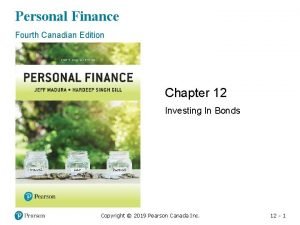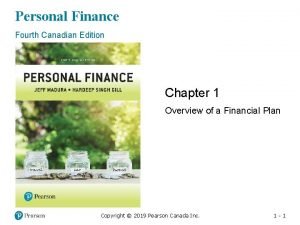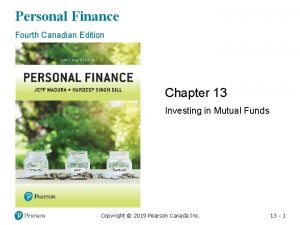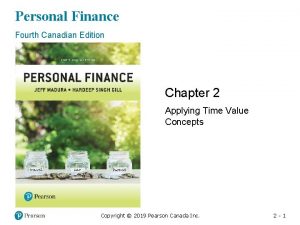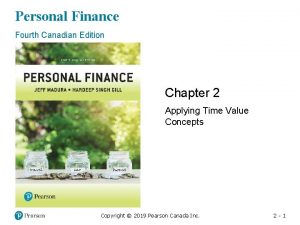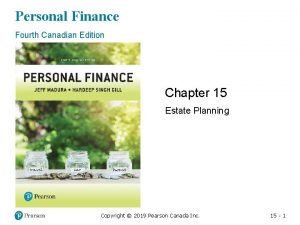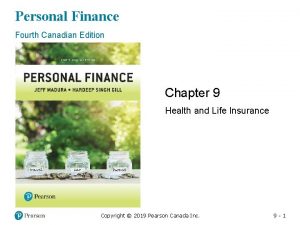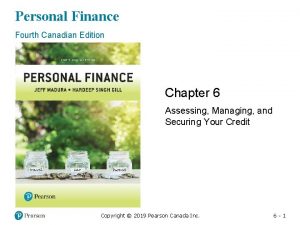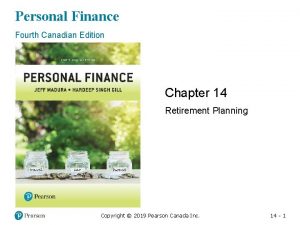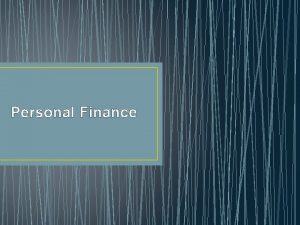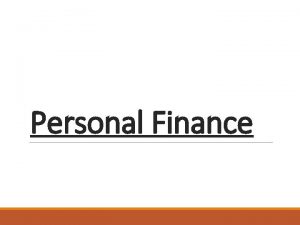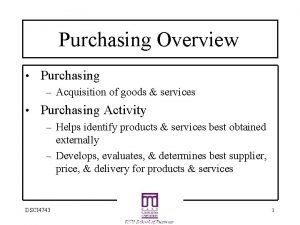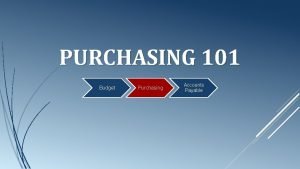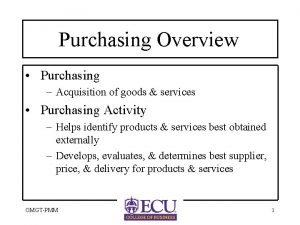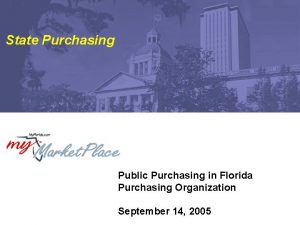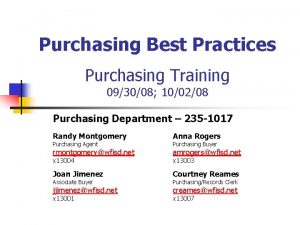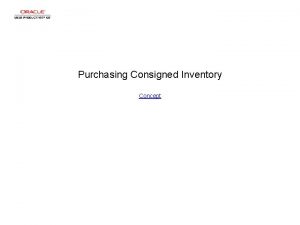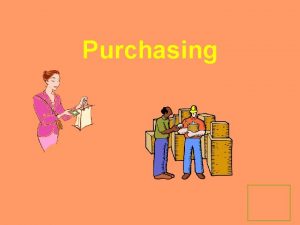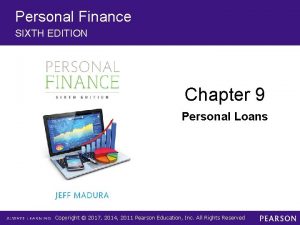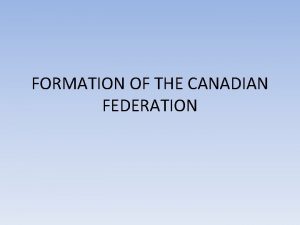Personal Finance Fourth Canadian Edition Chapter 7 Purchasing






















































- Slides: 54

Personal Finance Fourth Canadian Edition Chapter 7 Purchasing and Financing a Home Copyright © 2019 Pearson Canada Inc. 7 -1

Chapter Objectives • Explain how to select a home to purchase • Describe the transaction costs of purchasing a home • Describe the characteristics of various mortgage options • Describe the characteristics of a fixed-rate mortgage • Describe the characteristics of a variable-rate mortgage • Show to compare the costs of purchasing versus renting a home • Explain the mortgage refinancing decision Copyright © 2019 Pearson Canada Inc. 7 -2

Selecting a Home-Types • Single-family detached home • Semi-detached home • Duplex • Townhouse • Carriage Home • Manufactured/Mobile Home • Condominium Complex • Apartment Complex Copyright © 2019 Pearson Canada Inc. 7 -3

How Much Can You Afford? • Consider budget, down payment (5 -20%) and mortgage • Pre-approval certificate: guideline on how large a mortgage you can afford with rate guarantee • Gross debt service (GDS) ratio: your monthly mortgagerelated debt payments–including mortgage loan repayments, heating costs, property taxes, and half of any condominium fees–divided by your total monthly gross household income- 32% or less • Total debt service (TDS) ratio: your mortgage-related debt payments plus all other consumer debt payments divided by your total monthly gross household income- 40% or less Copyright © 2019 Pearson Canada Inc. 7 -4

GDS and TDS Example (1 of 2) Blake and Donna Braithwaite have asked their bank to help them determine whether they qualify for a mortgage on a $375 000 home on which they would like to make an offer. The couple will make a down payment of $75 000 and the mortgage will be amortized over 25 years. As part of its initial assessment, the bank has to calculate the couple’s GDS and TDS ratios. The current five-year fixed mortgage interest rate is 6 percent, compounded semi-annually. Based on its discussion with the couple, the bank gathers the following additional information: Blake’s monthly gross income = $3500 Donna’s monthly gross income = $3500 Monthly mortgage payment = $1919* Monthly heating costs = $120 Monthly property taxes = $250 Monthly consumer debt payment = $500 Copyright © 2019 Pearson Canada Inc. 7 -5

GDS and TDS Example (2 of 2) *The required information and calculator steps for the monthly mortgage payment will be discussed later in this chapter. GDS = ($1919 + $120 + $250) ÷ $7000 = 0. 3270 × 100 = 32. 70% TDS = ($1919 + $120 + $250 + $500) ÷ $7000 = 0. 3984 × 100 = 39. 84% The GDS ratio actually exceeds the previously stated max (though by only 0. 7%). Based on this initial assessment, it appears that they are eligible for a mortgage. The Braithwaites have qualified for their mortgage based on the current five-year fixed mortgage interest rate. If they are able to negotiate a lower rate than this, their financial position will be even better since their monthly mortgage payment will be less than the $1919 they were required to use as part of their GDS and TDS ratio calculations. Copyright © 2019 Pearson Canada Inc. 7 -6

Affordable Down Payment • What is the market value of the assets you will use to make your down payment? • Maintain some funds for liquidity purposes to cover unanticipated bills and closing costs • The Home Buyer’s Plan (HBP) can help first-time home buyers reach their goals – Allows each home buyer to “borrow” up to $25 k from their Registered Retirement Savings Pan (RRSP), interest-free with up to 15 years to pay back this “loan” Copyright © 2019 Pearson Canada Inc. 7 -7

Affordable Monthly Mortgage Payments • Refer to your cash flow statement • Replaces a rent payment but there are other periodic expenses to consider • The larger your mortgage payments, – the less you can add to your savings/investments, – the lower your liquidity, and – the greater your overall financial risk • Watch overbuying! Copyright © 2019 Pearson Canada Inc. 7 -8

Criteria Used to Select a Home (1 of 2) • Price – Stay within your budget, remember bank’s maximum is in their best interest, not yours • Convenient location • Maintenance – Newer vs. older homes – Large yards – Condo fees/assessments • School system Copyright © 2019 Pearson Canada Inc. 7 -9

Criteria Used to Select a Home (2 of 2) • Insurance – Higher for more expensive homes and homes in highrisk areas • Property Taxes (to pay for schools, parks, garbage services…) – Determined by the local mill rate • Resale value (location, location!) – Very dependent on economic and market conditions • Personal preferences Copyright © 2019 Pearson Canada Inc. 7 - 10

Relying on a Realtor • Realtors can assist you with assessing homes, deciding whether to buy a home, or determining which home to purchase • Home seller is responsible for paying a realtor commission – Traditionally, 7% of the selling price on the first $100 000 and 3% on the remaining price – Flat fees structures (e. g. , fixed percentage 2% or dollar amount of $2, 500) becoming more common Free App: REALTOR. ca Copyright © 2019 Pearson Canada Inc. 7 - 11

Using Online Realtor Services • Multiple Listing Service (MLS): an info database of homes available for sale through realtors who are members of the service – A marketing service – Administered and operated by the local real estate board • Other online services allow sellers to list their homes in a database without providing real estaterelated services (e. g. Com. Free) – Charges low, or no, commissions Copyright © 2019 Pearson Canada Inc. 7 - 12

Negotiating a Price • Most sellers are willing to accept less than their original asking price • Seller may accept, reject, or suggest you revise the offer – Contract can go back and forth a number of times • Contract stipulates the price, and may include conditions such as the completion of a home inspection, the move-in date, and the approval of a mortgage Copyright © 2019 Pearson Canada Inc. 7 - 13

Focus on Ethics: Disclosing Defects • The law requires disclosure of any defect that may affect the value of the home • Disclosure is not only legal, but moral • Failure to disclose can result in a lawsuit for misrepresentation Copyright © 2019 Pearson Canada Inc. 7 - 14

Transaction Costs of Purchasing a Home (1 of 2) • Down Payment – Represents your equity investment in the home – Conventional mortgage: a mortgage where the down payment is at least 20 percent of the home’s appraised value § Lender bears the risk that you may default on the loan § Down payment provides a cushion in situations where the lender has to repossess the home and sell it Free App: Ready Set Home Copyright © 2019 Pearson Canada Inc. 7 - 15

Transaction Costs of Purchasing a Home (2 of 2) • High ratio mortgage: a mortgage where the down payment is less than 20 percent of the home’s appraised value – Cushion provided by the down payment is lower – Lender will require that your mortgage be insured § In the event of default, a mortgage insurer insures a high ratio mortgage, thereby protecting the lender’s investment § Mortgage loan insurance premium may be paid immediately by the borrower, or add to the mortgage Copyright © 2019 Pearson Canada Inc. 7 - 16

CMHC Mortgage Loan Insurance Costs Exhibit 7. 1 CMHC Mortgage Loan Insurance Costs Loan-to-Value Ratio Standard Premium Up to and including 65% 0. 60% Up to and including 75% 1. 70% Up to and including 80% 2. 40% Up to and including 85% 2. 80% Up to and including 90% 3. 10% Up to and including 95% 4. 00% 90. 01% to 95% − Non-Traditional Down Payment 4. 50% Source: Based on Canada Mortgage and Housing Corporation. https: //www. cmhcschl. gc. ca/en/co/moloin_005. cfm Copyright © 2019 Pearson Canada Inc. 7 - 17

Sources for a Traditional Down Payment: • Own savings • RRSP HBP withdrawal • Non-repayable gifts from a parent • Money from the sale of another property Copyright © 2019 Pearson Canada Inc. 7 - 18

Sources for a Non-Traditional Down Payment • Borrowed money • Gifts • Lender cashback incentives Copyright © 2019 Pearson Canada Inc. 7 - 19

Mortgage Loan Insurance Example Paul Ezako makes a $20 000 down payment on a $350 000 home. Since the mortgage is a high ratio mortgage, the lender will need to purchase mortgage loan insurance. Paul decides that he would like the lender to add the mortgage loan insurance premium to his mortgage. Paul’s mortgage payments will be calculated based on the adjusted mortgage balance. Mortgage required = Value of home − Down payment = $350 000 − $20 000 = $330 000 Mortgage size as a percentage of lending value = $330 000 ÷ $350 000 = 0. 9429 × 100 = 94. 29% Paul has used his personal savings to make the $20 000 down payment. Since he has made a traditional down payment, the mortgage loan insurance premium is calculated using a rate of 4. 00 percent. Mortgage loan insurance premium = Mortgage required × Mortgage loan insurance rate = $330 000 × 4. 00% = $13 200 Adjusted mortgage balance = $330 000 + $13 200 = $343 200 Copyright © 2019 Pearson Canada Inc. 7 - 20

Vendor Take-Back Mortgage • a mortgage where the lender is the seller of the property – Buyer makes mortgage payments directly to the seller – Property title transfers to the buyer – If the buyer defaults on mortgage payments, the property transfers back to the seller – Alternative to a high ratio mortgage Copyright © 2019 Pearson Canada Inc. 7 - 21

Vendor Take-Back Mortgage Example Meredith and Jason Crane own a $450 000 home that has a remaining mortgage balance of $220 000. Bernard and Maria Santos would like to purchase the home. The couples have agreed that a vendor take-back mortgage would best meet their respective needs. The Santoses have a $50 000 down payment. A second mortgage for the amount of $180 000 would be arranged between the couples. Second mortgage required = ($450 000 − $220 000) − $50 000 = $180 000 The Santoses’ monthly mortgage payments will cover the existing mortgage payment currently paid by the Cranes plus the payments associated with the second mortgage. The Cranes will continue to make mortgage payments to their lending institution, and the payment they receive on the second mortgage will provide them with a regular source of income. Copyright © 2019 Pearson Canada Inc. 7 - 22

Closing Costs (1 of 2) • Home Inspection Fee • Appraisal Fee • Real Property Report/Land Survey • Land Transfer Tax (levied in Ontario, B. C. , Manitoba, Nova Scotia, & Quebec) • Legal Fees and Disbursements Copyright © 2019 Pearson Canada Inc. 7 - 23

Closing Costs (2 of 2) • GST/HST(paid on the purchase of a brand new home) • Title Insurance • Interest Adjustment • Prepaid Property Tax and Utility Adjustments • Homeowner’s Insurance • Loan Protection Life and Disability Insurance Copyright © 2019 Pearson Canada Inc. 7 - 24

Estimated Statement of Funds Required (1 of 2) Exhibit 7. 2 Estimated Statement of Funds Required SALE PRICE Blank $413 130. 38 DEPOSIT PAID (5% of sale price) $20 656. 52 Blank NET MORTGAGE (20% down payment) 330 504. 30 Blank 351 160. 82 Difference Blank 61 969. 56 Plus ABC Law Group Fees Blank 1000. 00 Re: Purchase and Mortgage Blank Other Charges Blank Printing Fee 15. 00 Blank Photocopying 42. 50 Blank 4. 93 Blank 42. 00 Blank 104. 43 Postage Fax Transmissions TOTAL OTHER CHARGES Copyright © 2019 Pearson Canada Inc. 7 - 25

Estimated Statement of Funds Required (2 of 2) Exhibit 7. 2 Continued Disbursements Blank Transfer of Land registration Blank 106. 00 Blank Land Titles Agent 20. 00 Blank Courier Charges 39. 00 Blank Certified Copies of Title & Fax Fee 4. 00 Blank Document Copy 7. 00 Blank Land Titles Searches 7. 00 Blank Tax Search and Certificate 31. 75 Blank Mortgage Registration 86. 00 Blank 300. 75 GST OF 5% ON FEES, CHARGES & DISBURSEMENTS Blank 57. 42 TOTAL AMOUNT REQUIRED Blank $63 432. 16 TOTAL DISBURSEMENTS Copyright © 2019 Pearson Canada Inc. 7 - 26

Examples of Closing Costs and Their Cost Exhibit 7. 3 Examples of Closing Costs and their Approximate Cost Who Takes Care of It? Approximate Cost Home inspection fee Buyer $350–$600 Appraisal fee Buyer $300–$500 Real property report/land survey Lawyer $1000–$2000 Legal fees and disbursements Lawyer $500–$1000 GST/HST Lawyer 5%– 15% Title insurance Lawyer $300–$400 Interest adjustment Lawyer $100–$1000 Prepaid property tax and utility adjustments Lawyer $300–$500 Homeowner’s insurance Buyer $700–$1000 Loan protection life and disability insurance Buyer Costs vary based on age of applicant(s) Copyright © 2019 Pearson Canada Inc. 7 - 27

Mortgage Options • Amortization Period - the expected number of years it will take a borrower to pay off the entire mortgage loan balance (max is 25 years, or 300 months) • Mortgage term- the period of time over which the mortgage interest rate and other terms of the mortgage contract will not change (6 months and 1, 2, 3, 4, 5 and 10 years) • Payment Frequency- the frequency with which you make a mortgage payment Copyright © 2019 Pearson Canada Inc. 7 - 28

Mortgage Payment Option Calculations Exhibit 7. 4 Mortgage Payment Option Calculations Mortgage Payment Frequency Number of Payments per Year Calculation Monthly 12 Blank Semi-monthly (twice per month) 24 Monthly payment ÷ 2 Biweekly (every two weeks) 26 (Monthly payment × 12) ÷ 26 Accelerated biweekly 26 Monthly payment ÷ 2 Weekly (every week) 52 (Monthly payment × 12) ÷ 52 Accelerated weekly 52 Monthly payment ÷ 4 Copyright © 2019 Pearson Canada Inc. 7 - 29

Time and Interest Savings Example Exhibit 7. 5 Time and Interest Savings for a $250 000 Mortgage, Amortized over 25 Years at an Interest Rate of 6% Compounded Semi-Annually Mortgage Payment Frequency Monthly Periodic Payment Amount Number of Months to Pay Down Mortgage Interest Paid Interest Saved $1600 300 $229 855 $0 Semi-monthly 800 299 228 505 1350 Biweekly 738 299 228 401 1454 Accelerated biweekly 800 252 187 315 42 540 Weekly 369 299 227 781 2074 Accelerated Weekly 400 252 186 822 43 033 Copyright © 2019 Pearson Canada Inc. 7 - 30

Mortgage Type • Closed mortgage: restricts your ability to pay off the mortgage balance during the mortgage term unless you are willing to pay a financial penalty – More popular due to lower interest rates (but consider lack of prepayment privileges) • Open mortgage: allows you to pay off the mortgage balance at any time during the mortgage term Copyright © 2019 Pearson Canada Inc. 7 - 31

Mortgage Options Example TVM Copyright © 2019 Pearson Canada Inc. 7 - 32

Characteristics of a Fixed-Rate Mortgage (1 of 2) • A mortgage in which a fixed interest rate is specified for the term of the mortgage • Preferred during rising interest rates • Lenders usually willing to negotiate below posted rates Copyright © 2019 Pearson Canada Inc. 7 - 33

Amortization Schedule • Discloses the monthly payments you will make based on: – a specific mortgage amount, – a fixed interest rate, and – an amortization period • Allocation of the Mortgage Payment – each payment includes repayment of a portion of the principal of the loan and an interest payment Copyright © 2019 Pearson Canada Inc. 7 - 34

Fixed-Rate Mortgage TVM Example Copyright © 2019 Pearson Canada Inc. 7 - 35

Fixed-Rate Amortization Schedule Solution (1 of 2) Exhibit 7. 6 Amortization Schedule for a Fixed-Rate, $300, 000 Mortgage Amortized over 25 Years at an Interest Rate of 6 Percent, Compounded Semi-Annually Month Payment Principal Interest Balance 1 $1919 $438 $1481 $299 562 2 1919 440 1479 299 122 … Blank 10 1919 458 1461 295 523 … Blank 25 1919 493 1426 288 380 … Blank 49 1919 554 1365 275 795 … Blank Copyright © 2019 Pearson Canada Inc. 7 - 36

Fixed-Rate Amortization Schedule Solution (2 of 2) Exhibit 7. 6 Continued Month Payment Principal Interest Balance 100 1919 713 1206 243 559 … Blank 150 1919 912 1007 203 031 … Blank 300 1919 1910 9 0 Copyright © 2019 Pearson Canada Inc. 7 - 37

Fixed-Rate Mortgage Example Notice also that the Braithwaites’ balance after 100 months is $243 559. This means that over the first eight years of the mortgage amortization period, the Braithwaites have paid off less than $57 000 of the loan outstanding on their home—in other words, less than 20 percent of the original mortgage amount. After 150 months (half of the life of the mortgage), their mortgage balance would be about $203 031, which means they would have paid off about one-third of the original $300 000 mortgage. The amount of Blake and Donna’s annual mortgage payment that would be allocated to paying off the principal is shown in Exhibit 7. 7. In the first year, they would pay off only $5399 of the principal, while the rest of their mortgage payment, $17 634, would be used to pay interest. This information is very surprising to the Braithwaites, so they review the mortgage situation further to determine whether it is possible to build equity—that is, pay off their mortgage— more quickly. Copyright © 2019 Pearson Canada Inc. 7 - 38

Principal vs Interest Paid Solution (1 of 2) Exhibit 7. 7 Allocation of Principal versus Interest Paid per Year on a $300 000 Mortgage Year Principal Paid in That Year 1 $5399 $17 634 2 5728 17 305 3 6077 16 956 4 6447 16 586 … … … 10 9192 13 841 … … … 15 12 353 10 680 … … … Copyright © 2019 Pearson Canada Inc. Interest Paid in That Year 7 - 39

Principal vs Interest Paid Solution (2 of 2) Exhibit 7. 7 Continued Year Principal Paid in That Year 20 16 601 6432 … … … 25 22 310 723 Copyright © 2019 Pearson Canada Inc. Interest Paid in That Year 7 - 40

Characteristics of a Fixed-Rate Mortgage • Impact of the Mortgage Amount on the Monthly Payment (large mortgage = larger mortgage payment) • Impact of the Interest Rate on the Monthly Payment (high interest rate = larger mortgage payment) • Impact of the Amortization Period on the Monthly Payment (longer amortization = lower payments but more interest payable in total) Copyright © 2019 Pearson Canada Inc. 7 - 41

Characteristics of a Variable-Rate Mortgage (1 of 2) • The interest charged on the loan changes in response to movements in a specific marketdetermined interest rate (prime rate) • Can be open or closed • Convertible mortgage allows you to renew your mortgage, before the and of the current mortgage term, without paying a penalty (‘lock in’ during rising rates) Copyright © 2019 Pearson Canada Inc. 7 - 42

Characteristics of a Variable-Rate Mortgage (2 of 2) • Interest Rate Index – Initial mortgage rate will be adjusted to stay in line with the prime rate of interest – Rate is set at prime plus a certain number of percentage points Copyright © 2019 Pearson Canada Inc. 7 - 43

Decision to Own versus Rent a Home (1 of 2) • Financial assessment of owning a home versus renting can be performed objectively and the consider personal preferences – Costs of Renting: § Monthly Rent Payments § Opportunity Cost of Security Deposit § Renter’s Insurance Copyright © 2019 Pearson Canada Inc. 7 - 44

Decision to Own versus Rent a Home (2 of 2) • Costs of Owning: – – – – Down Payment Monthly Mortgage Payments Opportunity Cost of the Down Payment Closing Costs Maintenance and Repair Costs Property Taxes Homeowner’s Insurance Copyright © 2019 Pearson Canada Inc. 7 - 45

Own versus Rent a Home Example (1 of 5) Maya Benson has found a home she desires and has researched the financing she needs. Before making a final decision, she wants to compare the cost of the home to the cost of remaining in her apartment. Although she would prefer a home, she wants to determine how much more expensive the home is compared to the apartment. If she purchases the home, she expects to live in it for at least three years. Therefore, she decides to compare the cost of owning a home to the cost of renting for the next three years. First, Maya calculates the cost of renting: • Cost of Rent. Her estimated cost of renting is shown in the top panel of Exhibit 7. 8. Her rent is currently $750 per month, so her annual rent is $9000 (computed as $750 × 12). She does not expect a rent increase over the next three years and therefore estimates her cost of renting over this period to be $9000 × 3 = $27 000. (If she had expected a rent increase, she simply would have added the extra cost to the estimated rent over the next three years. ) • Cost of Tenant’s Insurance. She does not have tenant’s insurance at this time, as the value of her household assets is low. Copyright © 2019 Pearson Canada Inc. 7 - 46

Own versus Rent a Home Example (2 of 5) • Opportunity Cost of Security Deposit. She provided a security deposit of $750 to the apartment complex. While she expects to be refunded this deposit when she stops renting, there is an opportunity cost associated with it. She could have invested those funds in a money market fund earning 2. 8 percent after tax annually, which would have generated annual interest of $21, assuming a tax rate of 30 percent (computed as ($750 × 0. 04) × (1 − 0. 3). The opportunity cost over three years is three times the annual cost, or $63. • Total Cost of Renting. Maya estimates the total cost of renting as $9021 per year and $27 063 over the next three years, as shown in Exhibit 7. 8. Maya determines the total cost of purchasing a home by adding up expenses and subtracting the value of the equity: • Mortgage Payment. The primary cost of buying a home is the mortgage payment, which she expects to be $867 per month, or $10 404 per year (not including payments for property taxes or home insurance). Copyright © 2019 Pearson Canada Inc. 7 - 47

Own versus Rent a Home Example (3 of 5) • Down Payment. Maya would make a down payment of $41 250 to buy the home. • Opportunity Cost of the Down Payment. If Maya did not buy a house, she could have invested the $41 250 in an investment and earned 2. 8 percent per year, after tax. Therefore, the annual opportunity cost (what she could have earned if she had invested the funds) is $1155, assuming a tax rate of 30 percent (computed as ($41 250 × 0. 04) × (1 − 0. 3). • Property Taxes. Maya assumes that the annual property tax will be $2500 based on last year’s property tax paid by the current owner of the home. • Home Insurance on this home will cost $600 per year (this estimate is based on the insurance premium paid by the current owner of the home). • Closing Costs. Closing costs (transaction costs) associated with buying a home must be included, although those costs are incurred only in the first year. The closing costs are estimated to be $3865. Copyright © 2019 Pearson Canada Inc. 7 - 48

Own versus Rent a Home Example (4 of 5) • Maintenance Costs. Maya expects maintenance costs on the home to be $1000 per year. • Utilities. She will pay for utilities such as water and electricity and will incur a cable TV bill if she buys the home. She already incurs those costs while renting an apartment, so she does not need to include them in her analysis. • Value of the Equity Investment. Another advantage of owning a home is that Maya will have an equity investment in it. Her down payment will be $41 250, and she will pay about $6188 in principal on her mortgage over the three-year period. • The value of this equity investment could be higher in three years if the market value of the home increases. As a conservative estimate, Maya expects the home to increase 10 percent in value over the next three years. Based on this assumption, the increase in the value of the home will be $16 500 ($165 000 × 0. 10). The value of the equity investment will be $63 938 (computed as $41 250 + $16 500 + $6188). Copyright © 2019 Pearson Canada Inc. 7 - 49

Own versus Rent a Home Example (5 of 5) • Total Cost of Purchasing a Home. The total cost of purchasing a home is determined by adding all expenses, and then subtracting the equity investment. As shown in Exhibit 7. 8, Maya estimates that the total cost of purchasing the home over the three-year period will be $28 154. The total cost of purchasing a home over three years is about $1091 more than the cost of renting. Maya decides that she wants to buy the home. Aside from the fact that she would rather live in a home than an apartment, Maya realizes that building equity in a home will put her further ahead, in the long term, than renting. Now that Maya has decided that she wants to purchase a home and can afford it, she submits her offer of $165 000, which is accepted by the seller. Copyright © 2019 Pearson Canada Inc. 7 - 50

Own versus Rent a Home Solution (1 of 2) Exhibit 7. 8 Comparing the Total Cost of Renting versus Buying a Home over a Three-Year Period Cost of Renting Blank Amount per Year Total over Next Three Years $9000 $27 000 Tenant’s insurance 0 0 Opportunity cost of security deposit 21 63 Total cost of renting $9021 $27 063 Cost of Purchasing Blank Mortgage payment ($867 per month) $10 404 $31 212 Down payment 41 250 (first year only) 1155 3465 Blank Rent ($750 per month) Opportunity cost of down payment Copyright © 2019 Pearson Canada Inc. 7 - 51

Own versus Rent a Home Solution (2 of 2) Exhibit 7. 8 Continued Blank Amount per Year Total over Next Three Years Property taxes 2500 7500 Home insurance 600 1800 Closing costs 3865 (first year only) Maintenance costs 1000 3000 Total costs Blank $92 092 Value of equity Blank $63 938 Cost of purchasing home over three years Blank $28 154 Copyright © 2019 Pearson Canada Inc. 7 - 52

Mortgage Refinancing (1 of 2) • Paying off an existing mortgage with a new mortgage that has a lower interest rate (not equal to a convertibility feature) • You will incur closing costs again and prepayment penalties • Savings on your monthly mortgage payments may exceed these costs and penalties Copyright © 2019 Pearson Canada Inc. 7 - 53

Mortgage Refinancing (2 of 2) • Rate Modification – Often referred to as a “blend-and-extend” option – Fixed-rate mortgage is revised to reflect the prevailing mortgage rate – Avoids costs/penalties associated with mortgage refinancing • Refinancing Analysis – Refinancing tends to be more beneficial when a homeowner plans to own the home for a longer period Copyright © 2019 Pearson Canada Inc. 7 - 54
 Sujata madan
Sujata madan Fundamentals of corporate finance canadian edition
Fundamentals of corporate finance canadian edition Purchasing images
Purchasing images Centralized purchasing and decentralized purchasing
Centralized purchasing and decentralized purchasing Chapter 8 personal finance
Chapter 8 personal finance Loan vocabulary
Loan vocabulary Project 2 fourth edition
Project 2 fourth edition Pathways algebra 2
Pathways algebra 2 Ethics in information technology fourth edition
Ethics in information technology fourth edition Ethics in information technology 6th edition answers
Ethics in information technology 6th edition answers Vertical line html
Vertical line html A computer programming team has 13 members
A computer programming team has 13 members Expert systems: principles and programming, fourth edition
Expert systems: principles and programming, fourth edition Marketing an introduction 6th canadian edition
Marketing an introduction 6th canadian edition Accounting principles second canadian edition
Accounting principles second canadian edition Accounting principles second canadian edition
Accounting principles second canadian edition Accounting principles second canadian edition
Accounting principles second canadian edition Accounting principles second canadian edition
Accounting principles second canadian edition Chapter 2 personal finance
Chapter 2 personal finance Foundations in personal finance chapter 1 summary answers
Foundations in personal finance chapter 1 summary answers Chapter 8 personal finance
Chapter 8 personal finance Chapter 4 post test personal finance
Chapter 4 post test personal finance Chapter 1 post test personal finance
Chapter 1 post test personal finance Overview of personal finance chapter 1
Overview of personal finance chapter 1 Corporate finance tenth edition
Corporate finance tenth edition Fundamentals of corporate finance fifth edition
Fundamentals of corporate finance fifth edition Fundamentals of corporate finance 6th edition
Fundamentals of corporate finance 6th edition Corporate finance tenth edition
Corporate finance tenth edition Corporate finance tenth edition
Corporate finance tenth edition Corporate finance tenth edition
Corporate finance tenth edition Corporate finance tenth edition
Corporate finance tenth edition Using mis 10th edition
Using mis 10th edition Using mis (10th edition) 10th edition
Using mis (10th edition) 10th edition Chapter 5 purchasing and inventory
Chapter 5 purchasing and inventory Chapter 6 consumer purchasing and protection
Chapter 6 consumer purchasing and protection Chapter 3 your purchasing power
Chapter 3 your purchasing power The basic rule of a risk-to-return relationship is that
The basic rule of a risk-to-return relationship is that Personal finance gcse
Personal finance gcse Mypersonalfinancelab
Mypersonalfinancelab Unit 3 business finance
Unit 3 business finance Personal finance lab
Personal finance lab Llc advantages and disadvantages
Llc advantages and disadvantages Personal finance lab
Personal finance lab Financial life cycle
Financial life cycle Personal finance lab
Personal finance lab Personal finance bell ringers
Personal finance bell ringers Personal finance assignment
Personal finance assignment Personal finance lab
Personal finance lab Personal finance lab
Personal finance lab Principles of business and finance unit 1 test
Principles of business and finance unit 1 test Personal finance unit 1 review
Personal finance unit 1 review Personal finance module
Personal finance module Glencoe personal finance
Glencoe personal finance The five foundations of personal finance
The five foundations of personal finance Personal finance basics and the time value of money
Personal finance basics and the time value of money


